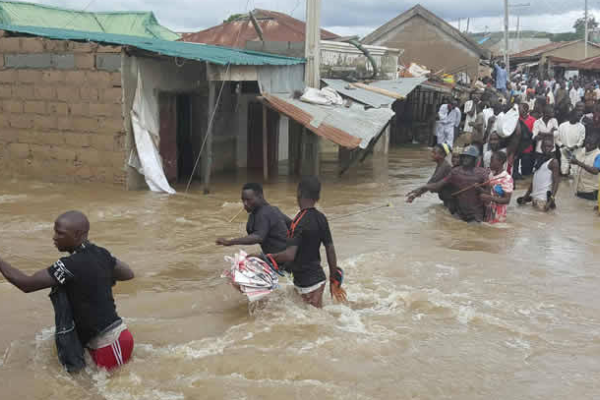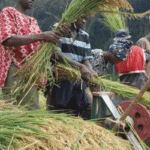Thanks to their low-lying topography and poor drainage system, Nigeria’s coastal states—Rivers, Bayelsa, Edo, Delta, Anambra, Ondo, and Cross River—become overrun with floods when it rains.
A few hours of unrelenting rain quickly leave homes submerged in large puddles of murky water that slow down traffic. To get ahead, residents typically wade through the floods.
This desperate act of necessity, however, is not without risk.
Mbagwu Chiezugorom Favour, a specialist in public health, explains that “floodwaters contain sewage, animal waste, industrial chemicals, and sharp debris.”
Floodwaters act as a perfect conduit for organic waste, such as the urine of rodents displaced by rising water levels, that can penetrate the body through exposed skin.
Leptospirosis, caused by Leptospira interrogans, is a notable bacterial infection. The disease thrives in warm, stagnant floodwater contaminated by animal urine.
The infection invades the skin through tiny cuts or insect bites, triggering high fever, chills, muscle aches and, in severe cases, jaundice and kidney failure.
The National Institutes of Health estimates that leptospirosis infects over 1 million people annually, causing roughly 60,000 deaths worldwide.
Despite limited national surveillance in Nigeria, studies have found antibody prevalence rates between 13.5% and 20.4% in certain communities. This suggests that exposure is far more common than recognised.
But the danger goes beyond leptospirosis.
Bacteria like Staphylococcus (which causes boils, abscesses, or serious infections through cuts), Streptococcus (germs from the throat or skin) and Pseudomonas (water-loving bacteria that trigger a painful and potentially life-threatening infection of the skin called cellulitis) also flourish in floodwater.
Favour explains that an immediate reaction is a skin rash, which many dismiss as a mild irritation. “But they can escalate quickly into swelling, abscesses, and fever if not treated early,” she cautions.
Cellulitis, for instance, can develop within 24 and 72 hours after exposure, rippling fast through the underlying tissue.
Leptospirosis symptoms usually appear between 2 and 10 days after exposure.
Fungal infections are another likely hazard. Continual dampness, combined with prolonged exposure to dirty water, creates perfect breeding conditions for fungi.
An infection sets off itching, peeling skin or thickened nails, which many label “athlete’s foot.” These spread unchecked among family members.
This nonchalance towards floodwater presents the real tragedy. Adults cross floodwaters daily without concern; children bask in them.
Public health experts link this behaviour with familiarity. “When people have lived with floods all their lives, they stop fearing what they don’t see,” says Favour.
She calls for community-based education through radio jingles, school programmes, market sensitisation, and local influencers to reinforce the dangers of floodwater.
Protective behavior, while simple, can save lives. If one must cross flooded areas, wearing rubber boots or wrapping the legs in thick plastic bags can act as effective barriers.
After crossing, people should wash thoroughly with soap and clean water, disinfect any cuts, and avoid touching the face or mouth before cleaning up.
Even temporary waterproofing–using polythene or improvised barriers–can significantly reduce exposure risk.
Covering every scratch or wound before contact with floodwater is critical because these small openings are “doorways for germs,” as Favour puts it. Once bacteria or parasites gain entry, they can multiply rapidly beneath the skin and, in severe cases, enter the bloodstream.
The wider picture reveals a dangerous intersection of climate change, poverty, and weak infrastructure.
Floods displaced over 1.4 million people in 2022, destroyed more than 200,000 homes and killed over 600 people nationwide.
As recently as May 2025, the Mokwa flood claimed more than 150 lives, displacing thousands and contaminating water sources. These physical disasters often translate into public-health emergencies.
Yet more can be done. Favour insists the public-health response must move beyond emergency relief to prevention and behavioural change. “We can’t keep treating after infection; we need to protect from exposure.”
Mass distribution of protective footwear in high-risk areas and routine community training on infection recognition can play a prominent role. “If a mother knows that her child’s fever after a flood might be leptospirosis, she will seek help faster,” she adds.
Local governments can also deploy community health volunteers: residents trained to identify early infection symptoms and disseminate timely information.
Traditional rulers and faith leaders can reinforce messages during flood warnings, urging communities to avoid wading barefoot.
Meanwhile, national agencies must ensure timely disinfection of flooded wells, clear clogged drainage systems before peak rainfall, and enhance surveillance for waterborne diseases.
Early signs such as redness, swelling, fever, or muscle pain should prompt urgent medical evaluation.
Informing the clinician of floodwater contact helps direct the right tests: blood cultures, Leptospira screening, or wound swabs, so that treatment starts early. In many cases, antibiotics or antifungal creams can prevent complications if administered promptly.
Nigeria’s floods are a public health battlefield. Each year, as the rains return, they bring not only destruction of homes and livelihoods but also an invisible tide of microbes waiting for human contact.
Summary not available at this time.






